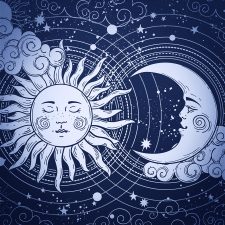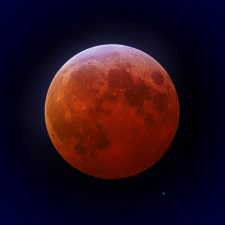The words “full moon” in many languages

It is said that there are more than 6,000 languages worldwide (this is hard to imagine) and it is a fascinating concept to think, there are probably as many words for “full moon”.
Here we begin our little journey to the full moon. A few words about the fascinating quest of the greater purpose, that includes the full moon circulating through our lives. In layman’s terms and not always scientific (astronomy experts – don’t look too closely!). We would like to wish you illuminating moments. Enjoy!


It is said that there are more than 6,000 languages worldwide (this is hard to imagine) and it is a fascinating concept to think, there are probably as many words for “full moon”.

A full moon is when the Sun and the Moon are facing opposite, being in opposite direction from an Earth perspective.
This might feel astonishing if one imagines that the Moon is on one side, the Sun on the other and the Earth in between? Shouldn’t the Earth throw a shadow onto the Moon? Bingo – this is exactly what she does! But only when the Moon is exactly on the Earth orbit, the so called “ecliptic”. When this takes place, we speak of a lunar eclipse!

The Moon needs 27.33 days to circle around the Earth. Something that is also referred to as “sidereal time”. But because the Earth orbits the Sun, just like the Moon orbits the Earth, the Moon has to travel two further days in order to resume the same position to the Earth and Sun. This is then called the “sidereal time”. In order to determine the point of time of the reoccurring full moon, the sidereal time serves as basis.

We already know now that the moon month is mostly shorter than the calendar month, being on average approximately 29.5 days. If full moon falls on the first or second of a month, it is possible that another full moon occurs in the same month, for instance in July 2004:
Friday, 2 July 2004, 01:08:54 pm
Saturday, 31 July 2004, 08:05:06 pm
This event is also known as “blue moon”.

The answer is: “everywhere at the same time”. This refers to the so called Universal Time (UT) though, which is used for general astronomical events. We have already learnt that full moon is an astronomical event, where the moon, sun and the earth play a role by being in a specific position. So, full moon takes place at a specific time in the outer space. This point of time is specified by astronomers namely by the Universal Time.

There are multiple ways of approaching this question. If we look at it from a purely theoretical standpoint, we might be tempted to say that the full moon is infinitely short, since the phases of the moon are changing continuously. The moon is not yet quite full shortly before the full moon, and is already waning shortly afterwards.
However, there is a practical aspect that lets us quantify the full moon as a finite and measurable span of time: Since the Sun is significantly bigger than the Moon, its rays are able to reach just a little over half of the Moon’s surface. This means that the timespan in which the visible side of the Moon’s surface is irradiated (as seen from Earth) is longer than infinitely short.

Whether scientists, astrologers or esoterics, they agree on one thing: the moon influences earth and life on earth. For instance, it regulates the tides through its magnetism. Also continents feel the consequence of this magnetism and either raise or lower their position sometimes up to 26 cm.

In nature it is a known fact: for some animal species, mating takes place at full moon. However, the examples that can be found on this subject are rather simple. Full moon serves in some cases indirectly as the cause (for instance through the high water levels during the tides that the horseshoe crab uses to deposit its eggs) or also as the signal for both sexes of a species to begin at the exact same time to safeguard their future existence (a particular type of fly or also corals). It is understood that also wolves are led by full moon when it is time to mate.

… that people are looking for an argument at full moon or are especially happy …
… that if full moon is surrounded by a haze, a person dies …
… that you raise your hat three times to the moon (being a man) or you make a curtsey (being a woman), in order to protect yourself from misfortune until the next full moon …
… that whoever does not chink glasses with full moon at least once, does not deserve any happiness [Greek toast] …

During a lunar eclipse, the Moon moves through the shadow of the Earth. Which means, that the Earth is positioned quite exactly between the Sun and Moon and casts its shadow onto the Moon. This is only possible at full moon and if some other requirements are met. Depending on whether the moon passes the partial or the core shadow of the Earth, we speak of a partial or total lunar eclipse.

“Lady and the Tramp” made in 1955, belongs to one of the most beautiful and most successful cartoons by Walt Disney. The story of the elegant female dog Lady and the fun-loving vagabond Tramp, shows how love can overcome social boundaries. In reality, this is of course a human issue and not one of our four-legged friends. However – as usual with Disney – it has been staged simply convincingly. And this is how a good acquaintance joins Lady and the Tramp in the nightly scenery: the full moon.
Let’s begin the New Year 2011 with the opening of the full moon blog. A true innovation to the full moon pages.

For everyone, who is not quite sure what a blog is, let’s say it is a kind of an Internet diary. The word »blog« is an abbreviation of »weblog«, which again derives from »web« (for Internet) and »logbook«, a term used in maritime shipping for recording daily events. Interestingly enough, it is mentioned in WIKIPEDIA that logbooks are of great importance in legal cases involving maritime commercial disputes, and therefore mandatory to be kept and not on a voluntary basis. As blogger (name of someone who writes in a blog), we certainly would not keep this rule, but encourage spontaneous participation and think it should be fun, and whenever possible, we will establish a connection to the full moon.

There are stories, they are so odd that they are hard to believe. Just a few days ago we came across this report, saying some multi-billionaires teamed up in order to buy the Moon. The motive for this unusual proposal is apparently an investment into future projects. It has been known for some time that the Moon could be significant for future utilization by people, and it therefore becomes a lucrative economic investment.
This is particularly about possible mineral resources, but also about the feasibility of creating moon colonies. Meanwhile, scientific studies have shown that the cultivation of plants – observed over extended periods of time – could create something like an atmosphere containing oxygen around the Moon. This is how a colonization on the Moon would be conceivable and it seems to be almost for certain that there should be enough volunteers, who would be willing to move away from Earth.
There are currently precisely six American flags on the Moon, which were left behind by the respective astronauts at the moon landings of the Apollo missions 11,12,14,15,16, and 17. The flag of the Apollo 11 mission led the way. On 21st July 1969 at 03:56 am (CET), Neil Armstrong was the first human to set foot onto our Moon and spoke the legendary sentence: »That’s one small step for (a) man … one … giant leap for mankind«. Together with his colleague Buzz Aldrin, he then planted the first flag on the Moon, which was apparently not so easy, due to the space suits, the pole rods and the condition of the ground.

This is about how to differentiate the waxing moon from the waning moon in the sky. »Waxing« is known to be the lunar phase between the new moon and the full moon (meaning the time when the crescent increases in size), whereas »waning« is known to be the lunar phase between the full moon and the new moon (the time when the crescent decreases in size). In order to remember on which side the curve is, here are some neat mnemonics.

Chang’e is the Chinese moon goddess. She does not symbolically represent the Moon, like for example the Greek moon goddess Selene, but Chang’e lives on the Moon and is befriended with the well-known rabbit that is very familiar to us. But has she always been up there?
The legend says that she got there some thousand years ago. There are different versions of the story, which we don’t want to elaborate on. In any case, her husband Hou Yi plays a central role, who came to help because of his skillfulness in archery, when ten suns threatened to burn the Earth and he shot down nine from the sky.

… this line from the poem “Evening Song” from 1778, by the poet Matthias Claudius (1740–1815), belongs to the best-known poems in German literature, not least of all because it was set to music many times; hence, it does not only remain in one’s memory because of its lyrics, but also because of its melody. Especially as a lullaby, everyone has surely heard it before or even sang it to the children:

The word “aggression” derives from the Latin verb “aggredi” which means »approach, attack«. This is interesting, because it does not only contain a destructive energy, but also a proceeding, solution-oriented energy. We also speak of tackling problems or approaching a task. During the course of the centuries, the component of attacking and destroying appears to have become dominant, so much so, that we judge aggression nowadays negatively and see the result to be destruction, violence and war. It is easily understandable now, why people are having such a difficult time to deal naturally with their aggressions that they express or restrain. We have put a negative mark on it. And we neither want to carry something negative inside us, nor do we want to voice it.

The Bible is undoubtedly one of the most important books in human history – most printed, most translated and worldwide the most widespread. It is the Holy Scripture of Christianity and Judaism (in different forms) and therefore the manifestation of God’s word in two of the major world religions.
The text contains, with its archaic, poetic language, many descriptions of nature and celestial events. So, it is obvious that the Sun, the Moon and the stars are mentioned. But is the full moon also to be found?

The full moon has always been a companion through time, through months, through seasons and the entire year. In the early days even more so, because daily life of people had not been strictly ruled by the clock yet. It was the sun that determined the day and the moon that brightened the night. Nowadays, clock and calendar are our time scales, which is advantageous but also contains a dark side. You unlearn more and more to estimate time periods and to experience them consciously. We have almost forgotten to perceive how different a full moon feels like in December compared to a full moon in July …